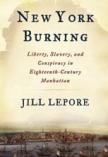Smoking Them Out
Readers of this absorbing book will learn a great deal about a politically ambitious English immigrant named Daniel Horsmanden, who, as a judge on New York’s Supreme Court, played a pivotal role in the transmutation of a sequence of robberies and suspicious fires in 1741 into a vast conspiracy of enslaved blacks intent on slaying their masters and taking over the city. Through the power of his pen, Horsmanden shaped the historical memory of this horrific and little-known episode in A Journal of the Proceedings in the Detection of the Conspiracy Formed by Some White People, in Conjunction With Negro and Other Slaves, for Burning the City of New-York in America and Murdering the Inhabitants, a book that has stood as the authoritative record of a perplexing chain of occurrences that led to the execution of more than 30 people, most of them African Americans, and, even at the time, was compared to the Salem witch trials.
The award-winning historian Jill Lepore rescues Judge Horsmanden from obscurity and, in a sense, puts him on trial for his complicity in the grisly burnings and hangings that were perpetrated in the name of justice in her ingenious retelling of these cataclysmic events. Weaving Horsmanden’s biography into a capacious and vibrant tapestry that illuminates the world of mid-18th-century New Yorkers, both black and white, she treats this controversial episode not solely as a cautionary tale in the city’s troubled history of race relations, as others have done, but as symptomatic of the social and cultural fault lines that defined life in this volatile colonial port.
Lepore sees New York’s turbulent political life and the ideas that informed it as key to understanding the conspiracy scare. What happened in 1741, she believes, becomes intelligible only in light of the ongoing conversation about liberty and slavery that had its origin in 18th-century English political culture and played out most dramatically in New York in the famous Zenger case about freedom of the press. The parallels between the contest over the right to express opinions in print and the impulse of slaves to extend their own liberty were striking. One has only to look at Horsmanden’s zeal in suppressing slaves, who he thought had gained an excess of liberty. Ultimately, Lepore succeeds in persuading us of the logic of looking at New York’s enslaved blacks as a City in a City (the term is from the philosopher Hobbes) striving to be heard or, as Horsmanden supposed, as political adversaries as formidable as the gentlemen who had backed Zenger and his cause.
An accomplished writer whose previous books include The Name of War: King Philip’s War and the Origins of American Identity and A is for American: Letters and Other Characters in the Newly United States, Lepore in New York Burning leads us through the developing stages of the crisis at a brisk pace in chapters with tantalizing one-word titlesIce, Fire, Stone, Paper, Water, Blood, Ink, Dustthat also probe themes relevant to her interpretation.
The chapter on water, for example, delves into the longstanding problem 18th-century New Yorkers had in obtaining uncontaminated water. The solution devised by people of means was to send their slaves daily to fetch tea water at Gerardus Comfort’s well on the city’s outskirts, a site adjacent to John Hughson’s tavern, where slaves met, socialized and allegedly conspired against the people who claimed to own them. Lepore’s excursion into the geography of the city, its health and sanitation issues, and the work routines of enslaved men answers a perennially puzzling question: How did African Americans, scattered in households all across New York City, manage to create a semblance of communal identity? She shows that a highly developed communications network, with its principal node at Comfort’s well, tied these dispersed slaves together.
Whether New York’s blacks, far more connected to one another than whites imagined, and surely with compelling reasons to break their chains, ever conspired to commit the deeds they were charged with remains an open question. Horsmanden, a man poisoned by racial animus, was keen to give credence to the theory that the mayhem was planned and cunningly wrung improbable confessions out of African Americans desperate to save their lives. But there were other potential culprits in sight whom even Horsmanden recognized, the most prominent being Catholics bent on destroying a valuable Protestant English colony. Purported evidence of a Roman Catholic conspiracy as embodied in the person of schoolmaster John Ury, suspected to be a priest who held sway over enslaved Africans, seemed credible to James DeLancey, another presiding judge. Late in the proceedings, he assigned ultimate responsibility for the calamity at New York to an overarching Catholic plot.
After combing Horsmanden’s text in conjunction with other contemporaneous sources, Lepore discerns four different plots of different degrees of probability. She trains her sights on the plots that spurred New Yorkers to acquiesce in the putting to death of more than a score of slaves and the exile of others and, consequently, downplays the role of anti-Catholic sentiment in the tragedy. White Protestant New Yorkers were well schooled in the potential for slave rebellion, but they were equally suggestible when it came to rumors of Catholic plots, having been nourished on tales of atrocities committed by papists.
At a time when the Spanish and the French stood as visible threats to the British colonies in America and the Catholic Pretender was just a few years away from launching the Jacobite Rebellion of 1745, it was easy for city dwellers to picture Catholics as the malevolent force behind the fires. Still, Lepore’s New York Burning does an outstanding job of demystifying Daniel Horsmanden’s influential text and changing how we think about an extraordinary year in New York’s early history.
This article also appeared in print, under the headline “Smoking Them Out,” in the January 2, 2006, issue.








